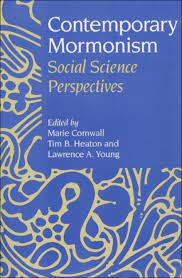Articles/Essays – Volume 30, No. 2
A Scholarly Feast of Contemporary Mormonism | Marie Cornwall, Tim B. Heaton, and Lawrence A. Young, eds., Contemporary Mormonism: Social Science Perspectives
The editors of this book have assembled a plethora of outstanding social science scholarship. The works selected are astute, readable, and thought-provoking. The book is filled with research in almost prose form, as well as quantitative and qualitative analyses of issues important to Mor monism today.
Particularly striking is an article by Marie Cornwall. “The Institutional Role of Mormon Women” is a compel ling look at women’s roles in religion, specifically Mormonism. With some Jewish comparisons as a foreground, Cornwall documents the role of women in the Mormon religion from its inception to the present day. The piece is not rancorous, but rather fair and even with its treatment of the topic.
Cornwall finds that historically the role of women in Mormonism was generally ambiguous. More avenues for contribution were available through Joseph Smith, but these have disappeared as the church has become larger and more bureaucratic. She believes that through bureaucracy men were given ever expanding roles, while women were assigned a specific sphere which emphasizes the notion that women are an “organizational li ability” thereby increasing their invisibility and silence in the church bureaucracy (261).
The book does not shy away from controversial topics such as missionary companionship. “The Mormon Missionary Companionship” by Keith Parry is an ethnographic study rich in comparisons of the social values of young, Mormon, male missionaries with young men trained in “bush” schools. The comparisons demonstrate the discovery of “self” and “other” as a missionary is taught by peers and near-seniors, as well as by authority figures, as in “bush” schools. This is only one of Parry’s emphases. One finding brushes on the gender-based missionary roles in the church, with the basic expectation that a young woman is discouraged from serving a mission (203). The views are sociologically compelling through the focus on male roles, male mentoring, and male role models for missionaries. His conclusions are thought-provoking and hopefully motivating.
Another interesting article deals with religion and mental health. This study by Allen E. Bergin, I. Reed Payne, Paul H. Jenkins, and Marie Cornwall concludes that there are many variables associated with mental health, with religion being only one. Commitment to religion is some what a factor in determining mental health. Separating factors to make a claim that religion definitely affects mental health was not a leap the authors were willing to take. They do claim that education and gender may be more predictive of depression than church affiliation, but this is not distinct for Mormons.
The role of minorities in the church is also addressed. Bruce Chad wick and Stan Albrecht give a historical account of Mormons relationships to Native Americans. Particularly they study programs, policies, and practices as well as beliefs. Two articles look at the church’s history and policies on blacks in the United States and Africa.
The South American mission experience is examined by David Knowlton in “‘Gringo, Jeringo’: Anglo Mormon Missionary Culture in Bolivia.” Through delightful stories, myths, folkways, and lore, Knowlton examines the complicated life of the missionary in Bolivia. The stories in themselves are a reason to buy the book. The myths and stories differ from one another, yet in the telling become contoured to find current attitudes and needs of the audience and culture.
There is not one article in this book that I couldn’t recommend reading and studying. The length of the articles make them easily digestible during a lunch hour, or as a refresher after a busy day at work.
Contemporary Mormonism: Social Science Perspectives. Edited by Marie Cornwall, Tim B. Heaton, and Lawrence A. Young (Urbana: University of Illinois Press, 1994).


 Back to full Issue
Back to full Issue

